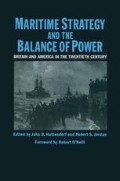Abstract
For the first two decades of the post-Second World War era, strategic thinking in the navies of Britain and the United States was dominated by a number of factors, some traditional and some novel. Of the traditional ones, the geostrategic situation of the two countries was much as it had been before the Second World War. There was also the perennial problem of having to match resources with commitments, and this was complicated by the difficulty of absorbing what seemed to be a permanent revolution in naval technology.1
Access this chapter
Tax calculation will be finalised at checkout
Purchases are for personal use only
Preview
Unable to display preview. Download preview PDF.
Notes
For a unique and well-informed survey of the way technical developments affected naval policy in the postwar period, see N. Freidman, The Postwar Naval Revolution (London, 1986).
Quoted in L. B. T. Ross ‘Chester William Nimitz’ in R. W. Love, Jr (ed.), The Chiefs of Naval Operations (Annapolis, 1980) p. 188.
Quoted in D. A. Rosenberg, ‘American Postwar Air Doctrine and Organisation: The Navy Experience’, A. F. Hurley and R. C. Ehrhart (eds), Air Power and Warfare: The Proceedings of the Eighth Military History Symposium, United States Air Force Academy 1978 (Washington, DC, 1979).
For discussion of this, se E. J. Grove, Vanguard to Trident: British Naval Policy Since World War II (Annapolis, 1987) pp. 65–8.
The published version of the ‘Dropshot’ 1949 long-term war-plan edited by A. Case Brown under the title Operation World War II (London, 1978) p. 163.
J. J. Sokolsky, Seapower in the Nuclear Age: NATO as a Maritime Alliance, Doctoral Dissertation presented to Harvard University, 1984, pp. 65, 68–9.
R. Tamnes, ‘Norway’s Struggle for the Northern Flank, 1950–2’, in O. Riste (ed.), Western Security: The Formative Years (Oslo: Norwegian University Press, 1985).
Quotation P. Ziegler, Mountbatten, the Official Biography (London, 1985) p. 519.
G. G. Gorshkov, quoted in R. W. Herrick, ‘Soviet Naval Strategy’ (Annapolis, 1968) p. 68.
Minister of Defence, Defence Outline of Future Policy, April 1957, CMND 124 (London, 1957), paragraph 24.
B. Ranft and G. Till, The Sea in Soviet Strategy (London, 1983) pp. 108–9.
See the beginnings of this in ADM 205/102, notably a very prescient paper by the Controller, Sir Ralph Edwards, ‘Future Strategy’, 6 May 1954.
NSC 68: A Report of the National Security Council, reprinted in Naval War College Review, May-June 1975, p. 60.
U.S. Congress, House Appropriations Committee, Hearings on the Fiscal Year 1963, Defense Budget 87th Congress, 2nd Session, 1962, 9 66.
P. R. Schratz, ‘Paul Henry Nitze’ in P. E. Coletta (ed.), American Secretaries of the Navy, Vol II 1913–1972 (Annapolis) p. 945.
Editor information
Editors and Affiliations
Copyright information
© 1989 John B. Hattendorf and Robert S. Jordan
About this chapter
Cite this chapter
Grove, E., Till, G. (1989). Anglo-American Maritime Strategy in the Era of Massive Retaliation, 1945–60. In: Hattendorf, J.B., Jordan, R.S. (eds) Maritime Strategy and the Balance of Power. St Antony's. Palgrave Macmillan, London. https://doi.org/10.1007/978-1-349-09392-2_13
Download citation
DOI: https://doi.org/10.1007/978-1-349-09392-2_13
Publisher Name: Palgrave Macmillan, London
Print ISBN: 978-1-349-09394-6
Online ISBN: 978-1-349-09392-2
eBook Packages: Palgrave Political & Intern. Studies CollectionPolitical Science and International Studies (R0)

